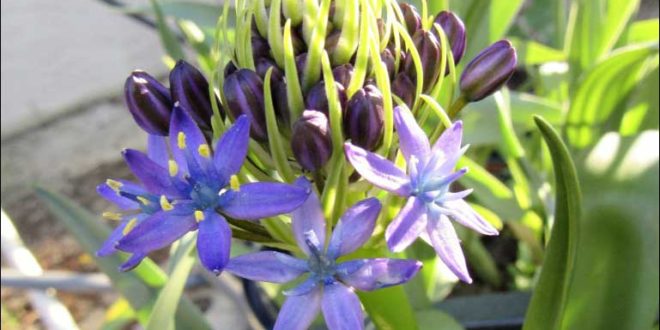Scilla peruviana is a evergreen perennial makes a spring-time statement with 50 to 100 deep-blue, starry blossoms atop large, cone-shaped flowers. Grow it alongside other spring flowering bulb crops such as daffodils, hyacinths and tulips. These unique flowers have an impressively long bloom time.
Short dark green strap-shaped leaves emerge in the fall to form tight rosettes to 18 inches across. In mid spring, from the center of the rosette, emerges one or occasionally several 6-12″ tall stalks bearing densely packed heads of deep blue colored flowers that last for a several weeks. A very easy plant to grow if given good drainage and a fairly lean soil. Given these conditions it can be irrigated though the dry season and be nearly evergreen or can be grown with little supplemental irrigation in mediterranean climate regions, such as Sunnyvale, where it sprouts after the first rain in the fall, blooms in spring then goes dormant over summer. Hardy to 5° F.
The name for the genus is the Greek name for Sea Squill (Urginea maritima) and the origin of this plant’s specific epithet is an interesting story: Scilla peruviana is native from southwestern Europe to western Africa. Plants were collected in Spain in the 17th century and shipped to England on a ship named “The Peru” but when later naming the plant Linnaeus thought the plant originated in the South American country of Peru and named the plant for its supposed origin. It has also garnered many common names that further confuse the gardener such as Hyacinth of Peru, Peruvian Lily and Star of Peru and names such as Caribbean Lily and Cuban Lily because this plant has naturalized in these areas.
First grown in our garden: 2017
nursery: Yamagami of Cupertino
Scilla peruviana is known to contain a glycoside similar to Digitalis and is considered poisonous if ingested.
In the landscape, mature plantings of Sapphire Blue grow to 18 to 22 inches in height. They should be grown in locations with full sun to light shade. They are perennials in USDA Hardiness Zones 7 to 10. They are relatively cold hardy and can tolerate light frosts down to 28° F without experiencing plant damage.
After planting, there should be approximately 1/2 to 1 inch of growing mix over the nose of the bulbs. Proper planting depth is critical for best plant growth, vigor and performance.
The growing mix should be kept moist, but not overly wet throughout production. Avoid allowing the media to dry down excessively, especially once they begin to flower. Scilla have light fertility requirements and only need to be fertilized sparingly to enhance foliage coloration. Irrigate with a 100 to 200 ppm of a balanced water-soluble fertilizer as needed to maintain plant coloration and growth. Avoid over fertilization or the foliage and blooms will appear loose and may not stand up well. The acceptable pH range is 5.5 to 6.5.
Insects and Diseases
There are relatively few insects and diseases affecting the production of scilla ‘Caribbean Jewel Sapphire Blue’. Aphids, fungus gnats, mealybugs, shore flies, thrips and whiteflies are the insects observed most frequently when producing scilla; however, these pests rarely become problematic. Several plant pathogens including Dreshlera and/or Helminthosporum leaf spot, Erwinia, Pseudomonas, rust, and Sclerotium may arise on occasion. For the most part, these diseases can be minimized or avoided by keeping the foliage as dry as possible using adequate plant spacing, providing adequate air movement, and watering early in day to avoid extended periods of wet foliage. Insects and diseases can be detected with routine crop monitoring; control strategies may not be necessary unless the scouting activities indicate actions should be taken.
Scilla does not require vernalization for flowering; cold treatments can actually damage the bulb and decrease flowering. The main factor influencing the timing of Sapphire Blue is temperature. Avoid high temperatures (over 70° F) as the plants will grow soft and leggy. The main key to success is to keep scilla in cool and bright growing conditions.








